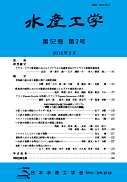47 巻, 2 号
選択された号の論文の10件中1~10を表示しています
- |<
- <
- 1
- >
- >|
-
原稿種別: 本文
2010 年 47 巻 2 号 p. 85-94
発行日: 2010/11/15
公開日: 2017/09/01
PDF形式でダウンロード (1133K) -
原稿種別: 本文
2010 年 47 巻 2 号 p. 95-100
発行日: 2010/11/15
公開日: 2017/09/01
PDF形式でダウンロード (759K) -
原稿種別: 本文
2010 年 47 巻 2 号 p. 101-112
発行日: 2010/11/15
公開日: 2017/09/01
PDF形式でダウンロード (1834K) -
原稿種別: 本文
2010 年 47 巻 2 号 p. 113-118
発行日: 2010/11/15
公開日: 2017/09/01
PDF形式でダウンロード (912K) -
原稿種別: 本文
2010 年 47 巻 2 号 p. 119-128
発行日: 2010/11/15
公開日: 2017/09/01
PDF形式でダウンロード (1187K) -
原稿種別: 本文
2010 年 47 巻 2 号 p. 129-138
発行日: 2010/11/15
公開日: 2017/09/01
PDF形式でダウンロード (999K) -
原稿種別: 本文
2010 年 47 巻 2 号 p. 139-142
発行日: 2010/11/15
公開日: 2017/09/01
PDF形式でダウンロード (511K) -
原稿種別: 本文
2010 年 47 巻 2 号 p. 143-148
発行日: 2010/11/15
公開日: 2017/09/01
PDF形式でダウンロード (585K) -
原稿種別: 本文
2010 年 47 巻 2 号 p. 149-160
発行日: 2010/11/15
公開日: 2017/09/01
PDF形式でダウンロード (1780K) -
原稿種別: 本文
2010 年 47 巻 2 号 p. 161-166
発行日: 2010/11/15
公開日: 2017/09/01
PDF形式でダウンロード (685K)
- |<
- <
- 1
- >
- >|
